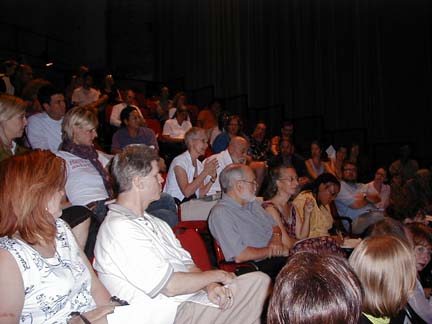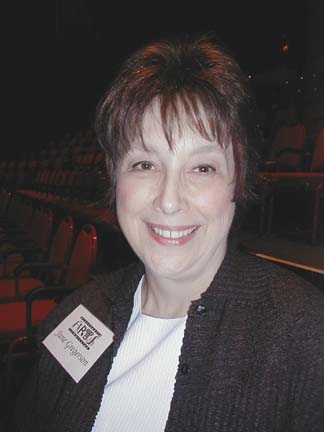The Plan: Minneapolis’ Brave New World of Art
Christopher Atkins attended the meeting that introduced the Minneapolis Plan for Arts and Culture. He found it to be an ambitious document that tries to move arts in the city closer to the center, but that could be more specific on how this is to be done.







Download the Minneapolis Plan for Art & Culture here: go to the link below and click. All photos this article, courtesy MPR’s Marianne Combs.
On Wednesday September 21, Theatre de la Jeune Lune hosted the Public Meeting to present the Minneapolis Plan for Arts and Culture. According to the Executive Summary, the effort is “a 10 year strategic plan that defines the role of the City in supporting arts and culture, and it defines the role of art and culture in accomplishing the City’s broader goals.” After a long gestation period during which a massive constituency was consulted, the Plan has now been presented as “an opportunity for arts and culture to become a true priority for the City, using its tools and resources with committed and focused leadership to fully integrate the arts into its daily business.” And in setting itself apart from the previous Culture Talks initiative that was disbanded in 2002, “This plan integrates cultural strategists into the City’s goals and businesses.”
In attendance at the Public Meeting was a cast of civic and cultural leaders along with the Minneapolis Art Commission, the body responsible for drafting and developing the Plan. The cast, from stage right, were Mayor R. T. Rybak, Ward 9 Council Member Gary Schiff, Roderic Southall of Obsidian Arts, Tom Daniel and Pamela Miner of the City’s Community Planning & Economic Development Department, Daniel Gumnit of Intermedia Arts, Neil Cuthbert of the McKnight Foundation, David O’Fallon from the McPhail Center for the Arts, and Kathy Halbreich, Director of the Walker Art Center.
Each member on the panel spoke briefly about their interaction with the Plan, how the Plan relates to their institutional interests, or made suggestions for what remains to be done. Mr. Southall spoke of bringing more African-American curators to Minneapolis, Ms. Miner implored the audience and Commission to implement the plan, while Ms. Halbreich suggested hiring an arts advisor for the city, a centralized arts advocate who would go to developers and patrons for public art funding.
With exacting detail and labored thoroughness, the Plan outlines what issues the Commission is facing and has found to be the most pressing to Minneapolis’s cultural community. Thankfully, we were spared a march through the 50-page entirety of the Plan, its summaries, and implementation. Instead, we were treated to Randy Hartten (former Chair of the Arts Commission) flipping through the recommendations Subterranean Homesick Blues-style to keep the meeting moving along. The seven recommendations, “in priority order,” are as follows, “#1 – Integrate and use arts and culture as a resource for economic development; #2 – Develop robust leadership on behalf of cultural development; #3 – Increase resources for arts and culture in Minneapolis; #4 – Strengthen the City’s public art program by providing a definite funding commitment and strengthening policy; #5 – Promote the City’s arts and culture to residents and visitors, and to civic and community leadership as an integral aspect of the City’s identity, quality of life, economic vitality and civic health; #6 – Promote collaborations among arts organizations, artists, the City and other partners; #7 – Preserve and strengthen arts education opportunities for Minneapolis youths.”
There were additional comments from the panelists in reference to the recommendations and the Plan in general. Mr. Gumnit from Intermedia Arts took an opportunity to point out, without going into more detail, that the Plan dealt specifically with issues of race and class. Mayor Rybak spoke of “an active and activist role” by the government of Minneapolis in administering to artistic and cultural issues. To these ends, the Mayor also spoke of “weaving” the arts into the “fabric” of the city, of bringing communities together, and being “organic.”
Having read the Plan since the Public Meeting, I can appreciate the Mayor’s edict to move the arts from the periphery of the City’s budget. I can clearly hear his desire to reintegrate the arts by increasing their visibility but somehow his words still ring a bit hollow. I was waiting for the Commission to elaborate a more nuanced understanding of the terms ‘culture,’ ‘art,’ and ‘community’ without breaking them up into “objectives” or translating them into bureaucratic language. Additionally, I searched the Plan for where Mr. Gumnit read the discourse on race and class but only found some brief observations, such as long-term outcomes that seek “a celebration of the unique expressions of all cultures.” Maybe we need something meatier than a few bullet-points?
Returning to the Mayor’s comments, ‘weaving’ and ‘fabric’ are convenient metaphors when talking about civic initiatives that seek to sustain a local arts community with financial assistance and oversight. These same metaphors help in articulating how this same local arts community can bridge cultural differences in the interest of community awareness.
But that’s just the problem: they’re convenient metaphors.
Used here, they are tidy summaries for much more complex relations and fissures between local residents, immigrant communities, and (un)sanctioned spaces of interaction. How does the City and the constituency consulted for this Plan consider the term ‘culture’? For all the talk of weaving the arts into the cultural fabric of the City and preventing the arts from being plunked on the periphery of the City’s stated goals and public outreach, is the panel at all interested in the blockages that prevent cultures from being sewn into the “basic fabric of the city”? Have they ever considered that cultures can more easily be thought of as permanently unstable things?
Although the Public Meeting did provide the audience with an opportunity to air some of their concerns about the recommendations, reading the Plan makes clear that the Commission’s imperative was to write and produce a ‘plan.’ A thorough understanding of cultures in the city would require listening to and articulating the complexities of art and culture as they relate to the cultures and communities of Minneapolis; it appears that this aspect of the planning process has been scanted. Thus the understanding of what would constitute locally relevant public art is perhaps overly simple, or too narrow. There is very little malleability in the bounds of public art projects, and little room to negotiate. For example, this quote portends a particularly constricted understanding of public art: “Throughout this planning process, there were frequent suggestions that the definition of public art be broadened to include performance and other transitory artistic expression [sic]. However, this proposal contradicts the City’s legal requirement that public art constructed using capital funding must be a permanent element of the physical infrastructure.” My commiserations to Minneapolis performance artists.
While I’ve taken issue with a small portion of it here, I must say that the Minneapolis Plan for Arts & Culture is an ambitious and mammoth undertaking. I encourage everyone to download a copy from the link provided here and read it. After spending some time with it, you will find that the Arts Commission has succeeded in collecting a massive amount of information for completing their diagnosis. You will also find that in spite of all this, there is still more work to be done. Of particular interest will be what happens when and if this plan moves off the shelf and into practice—when the rubber meets the road, if you will. Maybe then there will be some way to measure how the Plan is working and if its recommendations are being reached. After all, a plan (or an idea, for that matter) minus implementation is only a plan.